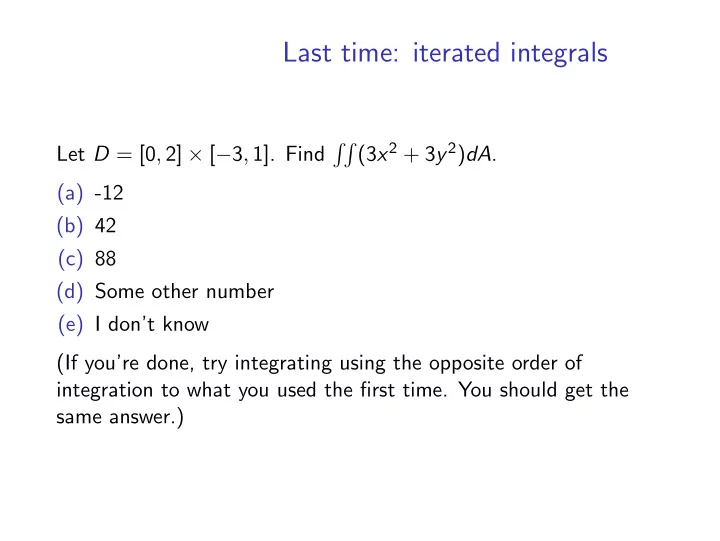

Last time: iterated integrals (3 x 2 + 3 y 2 ) dA . ∫︁∫︁ Let D = [0 , 2] × [ − 3 , 1]. Find (a) -12 (b) 42 (c) 88 (d) Some other number (e) I don’t know (If you’re done, try integrating using the opposite order of integration to what you used the first time. You should get the same answer.)
Solution ∫︂ 2 ∫︂ 1 ∫︂∫︂ (3 x 2 + 3 y 2 ) dA = (3 x 2 + 3 y 2 ) dydx 0 − 3 D ∫︂ 2 3 x 2 y + y 3 ]︁ 1 [︁ = − 3 dx 0 ∫︂ 2 (3 x 2 + 1) − ( − 9 x 2 − 27) [︁ ]︁ = dx 0 ∫︂ 2 12 x 2 + 28 dx = 0 = [4 x 3 + 28 x ] 2 0 = 32 + 56 = 88 .
Solution (opposite order) ∫︂ 1 ∫︂ 2 ∫︂∫︂ (3 x 2 + 3 y 2 ) dA = (3 x 2 + 3 y 2 ) dxdy D − 3 0 ∫︂ 1 x 3 + 3 xy 2 ]︁ 2 [︁ = 0 dy − 3 ∫︂ 1 8 + 6 y 2 ]︁ [︁ = dy − 3 8 y + 2 y 3 ]︁ 1 [︁ = − 3 = (8 + 2) − ( − 24 − 54) = 88 .
Recall: Fubini’s Theorem Theorem Let f be a continuous function on D = [ a , b ] × [ c , d ] . Then ∫︂ d ∫︂ b ∫︂ b ∫︂ d ∫︂∫︂ f ( x , y ) dA = f ( x , y ) dxdy = f ( x , y ) dydx . D c a a c More generally, this is true if f is bounded and is continous except at a finite number of smooth curves, provided that the iterated integrals exist.
Regions of Type I We say D ⊂ R 2 is of Type I if it is of the form D = { ( x , y ) | a ≤ x ≤ b and g 1 ( x ) ≤ y ≤ g 2 ( y ) } , where g 1 , g 2 : [ a , b ] → R are continous functions. Theorem Let f ( x , y ) be a continous function on a region D of type I as above. Then ∫︂ b ∫︂ g 2 ( x ) ∫︂∫︂ f ( x , y ) dA = f ( x , y ) dydx . g 1 ( x ) D a
Practice with regions of type II Recall the region D enclosed by the lines x = 0, y = 1, and the curve y = x 2 . To show that D is a region of type II, we need to find numbers c and d and continuous functions h 1 , h 2 on the interval [ c , d ] such that D = { ( x , y ) | a ≤ x ≤ b and g 1 ( x ) ≤ y ≤ g 2 ( y ) } . (a) I don’t know what to do. (b) I’m working on it. (c) I have answers, but they don’t match with my neighbour’s. (d) We agree.
Solution To find the interval c and d we look at the “shadow” produced by the region D on the y -axis. (Pretend a big light is shining from the far right side.) So we see that [ c , d ] = [0 , 1]. Now given a point y 0 in this interval, what values can x take? x must be larger than √ y 0 and smaller than 1. So h 1 ( y ) = √ y and h 2 ( y ) = 1.
Integrating over a region of type II Let D = { ( x , y ) | 0 ≤ y ≤ 1 and √ y ≤ x ≤ 1 } . How would you find the area of D ? Fill in the blanks in the following formula: ∫︂ ? ∫︂ ? Area of D = ? d ? d ? . ? ? (a) I don’t know what to do. (b) I’m working on it. (c) I have answers, but they don’t match with my neighbour’s. (d) We agree.
Solution D = { ( x , y ) | 0 ≤ y ≤ 1 and √ y ≤ x ≤ 1 } ∫︁∫︁ The area of D is D 1 dA ; since D is of type II we have ∫︂ 1 ∫︂ 1 ∫︂∫︂ 1 dA = 1 dxdy . √ y D 0
Practice with integrating over polar rectangles Let D = { ( x , y ) | 1 ≤ x 2 + y 2 ≤ 4 and 0 ≤ y } as before. What is ∫︂∫︂ ydA ? D (a) 0 14 (b) 3 (c) 3 (d) 3 π y 2 (e) I don’t know.
Solution Since D is a polar rectangle of the form with 1 ≤ r ≤ 2 and 0 ≤ θ ≤ π , we have ∫︂ 2 ∫︂ π ∫︂∫︂ ydA = ( r sin θ ) rdrd θ 0 1 D ∫︂ 2 ∫︂ π r 2 sin θ drd θ = 0 1 ∫︂ π [1 3 r 3 sin θ ] 2 = 1 d θ 0 ∫︂ π 7 = 3 sin θ d θ 0 = [ − 7 3 cos θ ] π 0 = 14 3 .
Recommend
More recommend